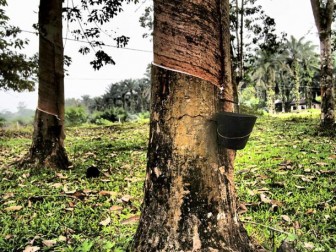 MUMBAI (Reuters) – Natural rubber imports could hit a record 22.5 percent of India’s total consumption in 2012/13 as a widening gap between local and overseas prices prompts tyre makers to bring in imports even during the peak domestic production season.
MUMBAI (Reuters) – Natural rubber imports could hit a record 22.5 percent of India’s total consumption in 2012/13 as a widening gap between local and overseas prices prompts tyre makers to bring in imports even during the peak domestic production season.
Usually, imports by the world’s fourth-biggest natural rubberproducer fall in October-March when local supplies climb as the weather is best for tapping.
This year, despite importing 23.5 percent more rubber in the first half, tyre makers are signing new import deals as buying locally is still expensive after farmers held back supplies hoping prices would rise in the future, industry officials said.
“Tyre makers were actively signing import deals in September. Then the difference between local and overseas prices widened to over 45 rupees per kg,” said George Valy, president of the Indian Rubber Dealers’ Federation.
On Monday, the spot price of the most-traded RSS-4 rubber (ribbed, smoked sheet) in the Kottayam market in India was 18,500 rupees per 100 kg, while Malaysian SMR 20, which Indian tyre makers prefer to import, stood at 15,649 rupees.
India imports rubber from Malaysia, Thailand and Indonesia.
“The difference is very big. It makes imports viable even if there is a duty on imports,” said N. Radhakrishnan, a dealer and former president of Cochin Rubber Merchants Association. “Tyre makers will continue imports in coming months. They are making savings by buying overseas.”
Rubber importers need to pay duty of 20 rupees per kg or 20 percent, whichever is lower, on overseas purchases.
The country’s total imports could rise to over 225,000 tonnes in 2012/13, up 5.2 percent on the year, Valy said.
In June, Sheela Thomas, chairman of the state-run Rubber Board, said India’s imports were likely to drop by 27 percent to 150,000 tonnes in 2012/13 on the back of a rise in local output and lower incentives to import rubber.
But since June the price difference between local and overseas prices has widened, peaking in September.
SUPPLIES PRESSURE
Daily rubber supplies to key spot markets are lower than normal as farmers are holding back produce.
“Farmers think speculators in futures market are depressing prices. They think in coming months prices will recover above 200 rupees (per kg),” Valy said.
In mid-August, the price in the local market fell to 16,900 rupees per 100 kg from 18,600 rupees a month earlier. The fall was short-lived and by mid-September it was at 19,500 rupees.
“Some farmers are not selling now, but they are continuing tapping. By mid-November this will lead to higher stocks,” said a Kochi-based dealer who declined to be named.
“Then they will be forced to sell. They will also realize charging a very high premium over the world market is not possible,” the dealer said.
Indian tyre makers are gradually trying to bring down their dependency on local supplies, which can be erratic and influenced by farmers’ price expectations.
In 2008/09, the south Asian country imported 77,762 tonnes of natural rubber, which accounted for only about 8.8 percent of total consumption.
The share of imported rubber in estimated consumption of 1.006 million tonnes in 2012/13 is likely to reach 22.5 percent, Valy said.
“We are aiming for 70/30 ratio. A few years back it was difficult to think about importing 30 percent of requirements, but the way prices are moving in the local and world market, it seems feasible,” said a senior official with a leading tyre company, who declined to be named.
Higher supplies due to a pick-up in tapping and more imports could depress prices in the Oct-Dec quarter, Radhakrishnan said.
(Reporting by Rajendra Jadhav; Editing by Jo Winterbottom and Richard Pullin)
Source: http://in.news.yahoo.com/india-tyre-makers-favour-imports-local-prices-soar-071624365–sector.html



























